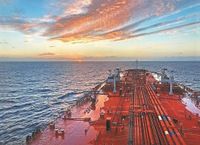Global shipping and energy security are facing a perfect storm of pressures, as new data reveals mounting risks in the world’s most vital maritime corridors and a shifting landscape for shipping giants like Greece. On September 10, 2025, Rystad Energy and Petrofin Research released separate but strikingly complementary reports: one warning of the growing fragility of maritime chokepoints that keep oil and liquefied natural gas (LNG) flowing, and the other highlighting Greek shipping’s strategic pivot as it navigates regulatory, economic, and geopolitical headwinds.
According to Rystad Energy, the arteries of global energy—narrow sea routes such as the Strait of Hormuz, the Strait of Malacca, Bab el-Mandeb, the Suez Canal, and the Turkish Straits—are more vulnerable than ever. In 2023, these chokepoints carried a staggering 71.3 million barrels per day (bpd) of oil and petroleum products and 26 billion cubic feet per day (Bcfd) of LNG. By 2024, those numbers had slipped to 65 million bpd and 24.8 Bcfd, a drop reflecting both temporary disruptions and longer-term shifts in global trade flows.
“Any disruption at these chokepoints could shatter supply chains, trigger sharp spikes in energy prices and inflict severe economic damage worldwide,” warned Mrinal Bhardwaj, Senior Analyst for Upstream Research at Rystad Energy, as cited by Rystad Energy. The warning comes as the world reckons with a series of crises—conflict, piracy, and environmental hazards—that threaten to upend the delicate balance of global energy supply.
For Asia and Europe, the stakes are particularly high. The United States, buoyed by rising domestic production, is somewhat shielded, but Asian and European economies remain heavily dependent on maritime routes. China, the world’s largest oil importer, is especially exposed to potential disruptions in the Strait of Hormuz and the Strait of Malacca.
The Strait of Malacca, which links the Indian Ocean to the Pacific, stands as the world’s busiest energy corridor. It moves about 24 million bpd of oil and gas, with China accounting for roughly half of the crude and condensate imports passing through. Saudi Arabia is the leading exporter along this route, responsible for a quarter of the flows. Despite the strait’s reputation for piracy, no major incidents have been reported this year—a rare silver lining in an otherwise turbulent picture.
Meanwhile, the Strait of Hormuz, sandwiched between Iran and the Arabian Peninsula, handles around 14 million bpd of oil and condensate—nearly one-fifth of global seaborne oil trade. It’s also a major conduit for LNG, with Qatar shipping about 16.3 Bcfd through the strait. China’s LNG imports via Hormuz have more than doubled over the past five years, reaching 2.7 Bcfd. The strait’s vulnerability was laid bare during the recent Iran-Israel conflict, when Iranian lawmakers proposed (but ultimately shelved) a bill to shut it down. “A closure would disrupt nearly half of Middle Eastern oil exports and send global prices soaring,” Bhardwaj cautioned, according to Rystad Energy.
To hedge against such risks, regional states have invested heavily in alternative pipelines. Saudi Arabia’s East-West Crude Pipeline can carry 5 million bpd, the UAE’s Abu Dhabi Crude Oil Pipeline handles 1.8 million bpd, and Iran’s Goreh-Jask pipeline offers another route—though none can fully replace the capacity or strategic importance of the maritime chokepoints.
Other critical passages are under similar strain. The Bab el-Mandeb Strait and the Suez Canal, which together form a crucial link between the Middle East and Europe, saw their traffic slashed by nearly half in the six months following a surge in Houthi attacks in late 2023. Many ships were forced to reroute around Africa—a costly and time-consuming detour. A complete closure of Bab el-Mandeb would block access to the Suez Canal, significantly raising costs for global energy trade.
In the north, the Turkish Straits—the Bosporus and Dardanelles—connect the Black Sea and the Mediterranean, carrying about 3.5 million bpd of crude oil, or 5% of global seaborne trade. Flows dipped during the pandemic and the Russia-Ukraine conflict but have since stabilized. Russia accounts for 40% of shipments through these straits, while Turkey itself imports about one-sixth of the total. Still, the narrow geography and ongoing geopolitical tensions make the straits perpetually vulnerable.
As instability in the Red Sea persists, the Cape of Good Hope has re-emerged as a vital alternative. Oil flows around the cape surged by almost 50% in 2024, reaching 8.7 million bpd. Much of this crude is bound for China, with significant volumes shipped from the US, South America, Saudi Arabia, and Iraq. Despite longer voyages and higher costs, the cape is currently seen as one of the safest options for crude transport.
All these risks come with a price. Insurance premiums and freight rates have already climbed as markets price in maritime hazards. “The energy market has proven resilient so far, but the growing fragility of these chokepoints leaves the world just one incident away from a major supply shock,” Bhardwaj said, as reported by Rystad Energy. About three-fourths of global oil demand moves through maritime chokepoints, with the Strait of Malacca and Strait of Hormuz alone accounting for nearly half of that traffic.
Against this precarious backdrop, Greek shipping remains a force to be reckoned with, even as it adapts to a world in flux. The latest survey by Petrofin Research for 2024, published by Petrofin Research, describes the year as one of “restraint” but also of strategic restructuring. The number of Greek-controlled shipping companies fell to 588 in 2024 from 592 the previous year, confirming a trend toward consolidation. Smaller companies, especially those with just one or two vessels, declined sharply—down 24.9% in terms of deadweight tonnage (DWT)—while larger companies with fleets of more than 25 vessels grew by 5.16%. These larger players now account for almost 69% of the Greek-controlled fleet.
The backbone of Greek shipping continues to be dry bulk carriers, with 2,921 ships and an increase of 128 vessels (a 4% rise in DWT) year-to-year. The tanker fleet grew by 24 vessels (1% DWT) to reach 1,004 ships, while containerships held steady at 489. Notably, the top 10 Greek shipowners dramatically boosted their presence in the sector, increasing their DWT by 63.5%. The LNG carrier fleet also expanded, adding six ships (a 4.4% DWT increase) for a total of 170 vessels.
Yet, the sector’s average annual growth slowed to 4% during 2020-2024, compared to 7% in the previous decade. Petrofin Research attributes this to a cocktail of challenges: geopolitical tensions in Ukraine and the Middle East, economic uncertainty, stricter emissions regulations, and high US interest rates that have restricted liquidity. Despite these headwinds, Greece leads in orders for "eco" ships, though only 3% of its order book is for purely green solutions. The majority are conventional vessels fitted with scrubbers, reflecting a cautious approach to new environmental mandates.
Strategic caution remains the watchword. Shipowners are taking a wait-and-see approach amid pressure from the European Union on emissions and a new US trade doctrine that could reshape global shipping patterns. As the world’s maritime lifelines face unprecedented risks, the resilience and adaptability of the shipping industry—and the nations that dominate it—will be tested as never before.
For now, the world’s oil and goods keep moving, but the margin for error is shrinking fast. One wrong move at a chokepoint, and the ripple effects could be felt from Singapore to Rotterdam, and from Athens to Beijing.




